HD 9817

Overlaid DSS image of HD 9817, 60' x 60' with north at top and west to the right
Aladin viewer for the region around HD 9817
Σ 138, BD+06 244, WDS J01360+0739, SAO 110001, GSC 00621-00864, HIP 7456
| Type | Star |
|---|---|
| Magnitude | 7.3 | Right Ascension | 1h 36' 2.9" (2000) |
| Declination | 7° 38' 43" N |
| Constellation | Pisces |
| Description | Binary 7.51/7.52 1.7" @ 60° |
| Classification | F8 |
Observing Notes
Andrew Cooper
Jul 30, 2023 Waikoloa, HI (map)
28cm f/10 SCT, NexStar 11" GyPSy @ 233x
Seeing: 6 Transparency: 7 Moon: 0%
A delicate pair with two 7th magnitude pale yellow stars separated by 2" aligned northeast to southwest, the 10th magnitude star visible 1' east-northeast is listed by WDS as the D component
Gaia EDR3 data indicates the 7th magnitude pair has closely matching parallax and proper motion while the D component, BD+06 245, is a background star, a C component is listed at 30" @ 80° but is 15th magnitude and also a background star
Captain William Henry Smyth
Nov 10, 1833 No. 6 The Crescent, Bedford, England (map)
150mm f/17.6 refractor by Tully 1827
An interesting close double star, in the space between the two Fishes, and the meander of the ribbon, about 15° from β Arietis, or nearly half-way on a line from that star towards η Ceti. A 6½, yellowish ; B 8, pale white, a third star following at some distance; probably Piazzi's "sequitur alia 6æ magnitudinis 8' circiter ad Boream." This beautiful object is No. 92 of William Herschels List of 145, and was registered by him in October, 1792. From his remark that the stars were less than half a diameter asunder, they must be widening; and in 1801 he found the angle of position to be only about 10°. Σ. entered it among the vicinæ on his First Class, and his results are :Pos. 20°00' Dist. l".467 Ep. 1830.23We may hence infer that this attendant comes has, during the last forty-two years, been performing a small north-east portion of its orbit; although its great proximity to the primary renders the circle so small as to greatly increase the necessity of long periods for obtaining satisfactory conclusions.
[ 60° 1".70 2018 WDS]
To M. Savary, —who has the merit of having first determined the elliptical elements of the orbit of a binary star from observation, we are indebted for a very ingenious suggestion, by which the dimensions of such orbit may be known. This method depends on the fact that light does not move instantaneously, but with a certain definite velocity, so that a specific time elapses between the moment when the ray leaves a luminous body and that when it enters our eye.
To apply this, in the present case, would be difficult indeed, since its accuracy must depend upon knowing the position of the orbit with regard to the eye; and noting exactly when the errant star is at the two opposite points of its orbit. Could these conditions be exact, the result is readily amenable to calculation; for admitting one of these components to revolve round the other in an orbit which is nearly parallel to our line of vision, it is evident that the one half of its orbit will be nearer us than the other, and that at the most distant point of its course the star will be removed from us to a distance nearly equal to the whole diameter of its orbit further than when at the point which is nearest the earth.
Hence Savary's rule: Observe the apparent times occupied by any revolving star, in going through the two halves of its orbit; and half the difference of these times will be the period in which light passes through the diameter of its orbit.
The principle of this is beautiful; and were it reducible to practice, the dimensions of such orbit could be approximated, —for as the velocity of light is a known quantity, the diameter may therefore be computed in miles if desired. But in addition to the obstacles already cited, the long interval of time which must intervene before such an observation can be completed, is a serious difficulty; as well as deciding upon the respective brilliance of the binary components.
[The Gaia DR2 data shows a good match in both parallax and proper motions for this pair]― A Cycle of Celestial Objects Vol II, The Bedford Catalogue, William Henry Smyth, 1844
Other Data Sources for HD 9817
Nearby objects for HD 9817
11 objects found within 120'
| 96 Piscium | HD 8949 | HD 8956 |
| IC 1721 | IC 1723 | Mu Piscium |
| NGC 631 | NGC 632 | NGC 638 |
| NGC 645 | NGC 652 |
Credits...
Drawings, descriptions, and CCD photos are copyright Andrew Cooper unless otherwise noted, no usage without permission.
A complete list of credits and sources can be found on the about page
HD 9817